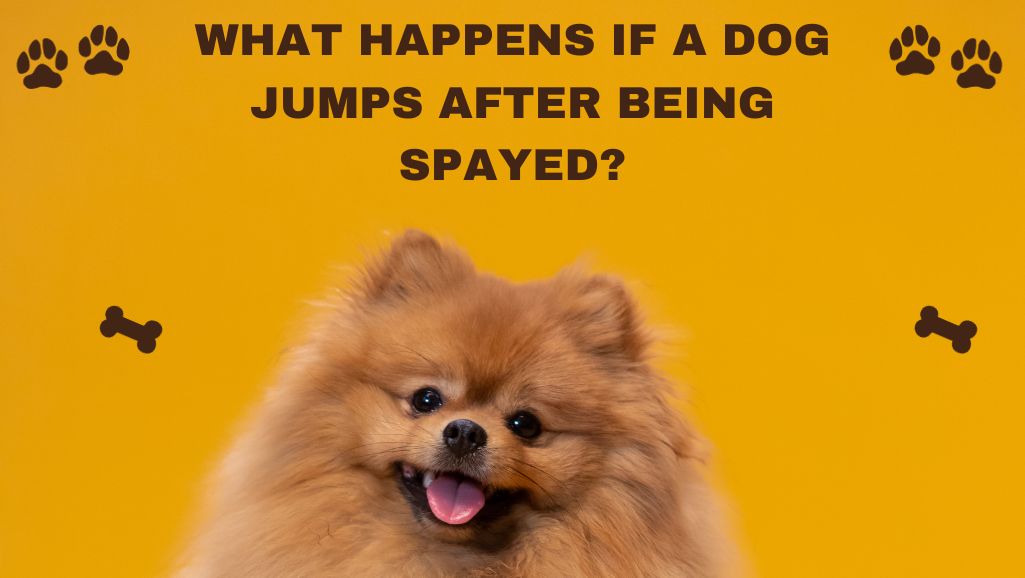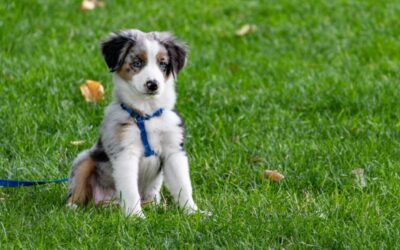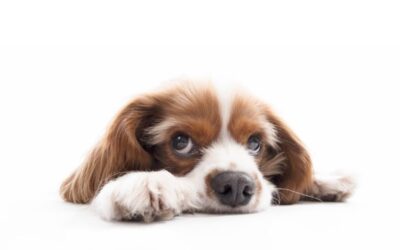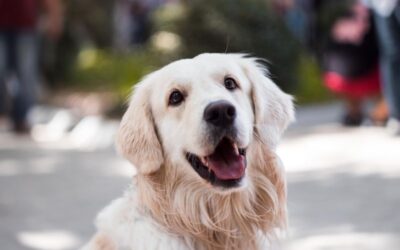After being spayed, if a dog jumps, it can put a strain on the surgical site and may lead to complications or delayed healing. Introducing physical activity too soon after the spay procedure can be risky for a dog’s recovery process.
- Understanding The Impact Of Jumping On The Healing Process
- Risks Associated With Jumping Too Soon
- Identifying Signs Of Discomfort Or Pain
- Steps To Minimize Jumping And Promote Healing
- Alternative Ways To Exercise Your Dog During Recovery
- Consulting The Veterinarian For Expert Advice
- Long-Term Impact And Benefits Of Proper Rest And Care
- Frequently Asked Questions Of What Happens If A Dog Jumps After Being Spayed
- Conclusion
Jumping or running can cause the stitches to tear or the surgical site to become inflamed, which may result in pain, bleeding, or infection. Restricting a dog’s movement and providing a calm and quiet environment to support healing is important.
Following the veterinarian’s instructions and closely monitoring the dog’s activity level can help prevent any potential issues. Ultimately, allowing the dog ample time to recover fully before engaging in any strenuous activities is crucial for their well-being and successful post-operative healing.
Understanding The Impact Of Jumping On The Healing Process
Jumping can hinder the healing process after a dog is spayed. It’s important to prevent such behavior to ensure a smooth recovery and avoid complications.
After a dog has been spayed, it is important to understand how different activities, such as jumping, can impact healing. In this section, we will explore the physical changes that occur after spay surgery and how jumping can affect the recovery.
So, let’s dive in and better understand the impact of jumping on the healing process.
Exploring The Physical Changes After Spay Surgery:
- The incision site: A small incision is made on the dog’s abdomen after spay surgery. This incision needs time to heal properly, and any excessive movement, including jumping, can put a strain on the incision site.
- Internal healing: The spay surgery involves removing the dog’s uterus and ovaries, and the body needs time to heal internally. Jumping can disrupt this healing process by causing excessive movement and strain on the internal organs.
- Swelling and inflammation: After the surgery, the body undergoes a natural healing process that includes inflammation and swelling. Jumping can exacerbate these symptoms and prolong the recovery period.
- To ensure proper healing, veterinarians often recommend restricted activity for dogs after spay surgery. Jumping should be avoided during this time to prevent any potential complications or setbacks in the healing process.
- Risk of complications: Jumping can increase the risk of postoperative complications such as swelling, bleeding, or even reopening of the incision. Providing a calm and controlled environment for the dog is crucial to minimize these risks.
Understanding the impact of jumping on the healing process is vital for the recovery of a spayed dog. Limiting jumping and providing a calm environment can help facilitate a smooth healing process and ensure the best possible outcome for your furry friend.
Remember, following your veterinarian’s instructions and maintaining a watchful eye on your dog’s activity levels during the recovery period is essential.
Risks Associated With Jumping Too Soon
After being spayed, dogs should avoid jumping too soon to minimize the risk of complications. Jumping can strain the incision site and lead to pain or even wound reopening. Proper rest and restricted activity are crucial during the healing process.
Jumping too soon after a dog has been spayed can lead to potential complications and hinder the healing process of the incision site. It is essential to understand the risks involved to ensure your dog’s well-being during the recovery phase.
Let’s explore the possible complications and the impact on the healing process:
Potential Complications From Excessive Activity:
- Hinderance of incision healing:
Excessive activity, including jumping, can put strain on the incision site, leading to delayed healing. Jumping can cause the stitches to pull or open, increasing the risk of infection and requiring additional medical attention.
- Increased pain and discomfort:
While jumping may seem normal for a dog, it can cause pain and discomfort after being spayed. The sudden pressure on the abdomen can result in discomfort and potentially disrupt recovery.
- Internal bleeding:
Jumping too soon can put stress on the internal organs, which may still be delicate after the surgery. This stress could potentially lead to internal bleeding, necessitating immediate medical intervention.
- Seroma formation:
Excessive physical activity, such as jumping, increases the risk of seroma formation. A seroma is a pocket of fluid that can accumulate near the incision site. This collection of fluid can delay healing and require draining.
- Potential hernia development:
Jumping too soon can also lead to the development of a hernia near the incision site. The strain from jumping can weaken the tissue surrounding the incision, allowing abdominal organs to protrude.
Ensuring your dog avoids jumping and excessive activity during recovery is vital for their overall well-being and a smooth healing process. Limiting their movement and providing a calm environment are essential steps to take after spaying.
Always consult your veterinarian for specific instructions regarding post-surgery care and restrictions. Your veterinarian will provide you with personalized guidance based on your dog’s unique needs.
Identifying Signs Of Discomfort Or Pain
After being spayed, it’s important to watch for signs of discomfort or pain in your dog. Keep an eye out for any changes in behavior, loss of appetite, excessive licking or biting in the surgical area, or reluctance to jump or move around.
If you notice any of these signs, consult your veterinarian for further evaluation and treatment.
Recognizing Signs That Your Dog Is In Pain Or Discomfort:
It is important to closely monitor your dog after they have been spayed to ensure that they are recovering well and not experiencing any pain or discomfort. Dogs may not always show obvious signs of discomfort, so looking out for any subtle changes in their behavior or physical condition is crucial.
Here are some signs to watch out for:
- Lethargy: If your dog is unusually tired or lacks energy, it could be a sign of discomfort or pain.
- Loss of appetite: If your dog is not eating as usual or shows a decreased interest in food, it may indicate discomfort.
- Restlessness or pacing: If you are unable to find a comfortable position, your dog may exhibit restless behavior or continuously pace around.
- Increased vocalization: Whining, whimpering, or excessive vocalization may indicate pain or discomfort.
- Excessive licking or grooming: If your dog is frequently licking the incision site or any other part of their body, it could be a sign of discomfort.
- Aggression or irritability: Your dog may display uncharacteristic aggression or irritability when touched or approached, which could be a sign of pain or discomfort.
- Swelling or discharge: Any unusual swelling or discharge around the incision site should be monitored closely, as it could indicate infection or complications.
- Changes in breathing: Rapid or shallow breathing, coughing, or wheezing may suggest pain or respiratory issues.
- Difficulty urinating or defecating: Struggling or showing signs of pain while urinating or defecating could be a sign of discomfort.
Monitoring The Incision Site For Any Complications Or Red Flags:
Keeping a close eye on the incision site is crucial to ensure proper healing and identify potential potential complications. Here are some things to look for:
- Swelling: Mild swelling around the incision is normal, but if it becomes excessive or continues to increase, it may indicate an issue.
- Redness or inflammation: Any signs of redness, heat, or inflammation should be monitored, as they can be indicators of infection.
- Discharge: While a small amount of clear or slightly bloody discharge may be normal, any excessive or discolored discharge should be addressed.
- Opening of the incision: If the incision site opens or separates, it is crucial to seek veterinary attention immediately.
- Excessive licking or chewing: Excessive licking or chewing at the incision site can delay healing or lead to infection, so it is important to address this behavior promptly.
Remember, each dog may exhibit different signs of discomfort or pain, so it is important to know your pet’s normal behavior and keep an eye out for any changes. Monitoring the incision site closely and seeking veterinary attention if any concerns arise will help ensure a smooth recovery for your furry friend.
Steps To Minimize Jumping And Promote Healing
To promote healing after being spayed, it is important to minimize jumping in dogs. This can be achieved by using protective clothing, providing a calm environment, limiting physical activity, and providing ample rest and care.
After your dog has been spayed, it’s important to take steps to minimize jumping and promote healing. Dogs can be naturally active, and excessive jumping can put a strain on the incision site, leading to complications. Creating a safe and comfortable environment for your dog and implementing strategies to prevent jumping and excessive activity can ensure a smooth recovery for your furry friend.
Creating A Safe And Comfortable Environment For Your Dog
- Set up a cozy recovery space: Create a designated area where your dog can rest and recover after the spaying procedure. Ensure it is comfortable, quiet, and free from objects that could encourage jumping.
- Provide soft bedding: Place soft and supportive bedding in your dog’s recovery space to avoid any discomfort or irritation to the incision area.
- Remove hazards: Ensure that the area is free from any potential hazards or obstacles that may encourage your dog to jump. This includes removing toys, furniture with enticing heights, or stairs.
- Use a recovery cone or alternative: To prevent your dog from licking or biting the incision site, use a recovery cone or alternative option, such as an inflatable collar or shirt. This will also discourage your dog from attempting to jump or strain the area.
- Ensure proper supervision: During recovery, it’s important to supervise your dog to prevent accidental jumping or excessive activity. This will allow you to redirect their attention and provide gentle reminders to stay calm and rested.
Implementing Strategies To Prevent Jumping And Excessive Activity
- Leash walks: Instead of allowing your dog to roam freely, take them on leash walks during recovery. This will help keep their activity level in check and prevent any sudden bursts of energy that could lead to jumping.
- Crate confinement: If your dog is used to being crate trained, confining them to their crate when unsupervised can be an effective way to prevent jumping. Ensure the crate is spacious and comfortable, with enough room for them to lie down and stretch comfortably.
- Use baby gates: Install baby gates in doorways or at the top of stairs to restrict your dog’s access to areas where jumping may be tempting. This will create a barrier and limit their movement to safer areas.
- Stay calm and provide mental stimulation: Keep interactions with your dog calm and avoid overexcitement, as it may lead to jumping. Instead, engage them in mental stimulation activities such as puzzle toys or training exercises to keep their mind occupied and their energy focused positively.
- Consult your veterinarian: If you have concerns about your dog’s healing process or excessive jumping behavior, don’t hesitate to contact your veterinarian. They can provide tailored advice and guidance based on your dog’s specific needs.
Following these steps and taking necessary precautions can create a safe environment and reduce the risk of jumping after your dog has been spayed. Remember to be patient and provide ample rest for your furry friend, allowing them to heal properly and enjoy a healthier future.
Alternative Ways To Exercise Your Dog During Recovery
Discover alternative ways to exercise your dog during recovery from spaying to prevent jumping-related complications. Engage your furry friend in low-impact activities like leash walks, puzzle toys, and mental stimulation games to ensure a safe and comfortable healing process.
Dogs are naturally active creatures, but after being spayed, they require a period of rest and recovery. It’s important to ensure that your furry friend receives the exercise and mental stimulation they need without putting any strain on their healing body.
In this blog post section, we will explore alternative ways to keep your dog engaged and prevent restlessness during their recovery process.
Low-Impact Exercises To Keep Your Dog Engaged And Prevent Restlessness:
- Gentle walks: Take your dog on short, leisurely walks around the neighborhood. Keep the pace slow and avoid vigorous activities that may cause discomfort or stress their healing incision.
- Swimming: If your dog enjoys water, swimming can be a great low-impact exercise option. Ensure that they are comfortable with swimming and choose calm, shallow waters. This activity provides exercise and helps with muscle toning and joint mobility.
- Interactive toys: Engage your dog’s mind while keeping them physically active by using interactive toys. Treating puzzles and food-dispensing toys will provide mental stimulation and help prevent boredom during their recovery.
- Controlled play sessions: Engage your dog in controlled play sessions that avoid any rough and high-impact activities. Consider gentle games like fetch with soft toys or hide-and-seek, where you hide treats for them to find.
Mental Stimulation Activities To Promote Healing And Prevent Boredom:
- Nose work: Encourage your dog’s natural scenting abilities by hiding treats or toys around the house for them to sniff out. This activity will keep them mentally engaged and promote healing by keeping their mind focused on a task.
- Puzzle toys: Invest in puzzle toys that challenge your dog’s problem-solving skills. These toys can include treat puzzles or interactive games that require them to manipulate objects or solve puzzles to access treats or toys.
- Training sessions: Utilize this recovery period as an opportunity to reinforce basic training commands or teach new tricks. Short training sessions provide mental stimulation and strengthen the bond between you and your dog.
- Enriched environment: Create an enriched environment for your dog by introducing new smells, sounds, and textures. Provide them with different types of toys, such as squeaky, chew, and plush, to keep their minds engaged and prevent boredom.
By incorporating these alternative ways to exercise and mentally stimulate your dog during their recovery, you can ensure their healing process is smooth and prevent them from becoming restless. Always consult your veterinarian for specific exercise recommendations based on your dog’s needs and recovery progress.
Consulting The Veterinarian For Expert Advice
After a dog is spayed, it is important to consult with a veterinarian for expert advice. If the dog jumps, it could cause complications or discomfort, so the veterinarian can provide guidance on how to manage the situation and ensure a smooth recovery.
After your dog has been spayed, it is important to consult with your veterinarian to ensure a smooth and successful recovery. By communicating with your veterinarian about your dog’s recovery progress, you can address any concerns and seek guidance on post-spay restrictions and recommendations.
Here are some key points to consider when consulting your veterinarian:
- Recovery progress updates: Regularly update your veterinarian on your dog’s recovery progress, including any changes in behavior or physical symptoms. This will help the vet monitor your dog’s healing process and ensure that there are no complications.
- Follow-up visits: It is essential to schedule and attend follow-up visits with your veterinarian as advised. These visits allow the vet to assess your dog’s overall health and recovery and provide any necessary treatments or adjustments to the post-spay care plan.
- Understanding post-spay restrictions: Seek guidance from your veterinarian regarding specific post-spay restrictions for your dog. These may include limitations on physical activity, such as running, jumping, and playing. Understanding and adhering to these restrictions is crucial to prevent complications and support proper healing.
- Medication administration: If your dog has been prescribed any medications, ensure you understand the correct dosage and instructions. Seek clarification from your veterinarian if you have any doubts or concerns about administering the medications.
- Monitoring incision site: Your veterinarian will guide you on how to monitor your dog’s incision site for any signs of infection or complications. Be sure to ask about the expected appearance of the incision site during the healing process and any warning signs to watch out for.
- Dietary considerations: Discuss any dietary recommendations with your veterinarian to ensure your dog receives the right nutrition during recovery. They can provide guidance on whether to adjust the diet and offer suggestions on suitable food options.
- Mental and emotional support: Your veterinarian can also provide advice on how to provide mental and emotional support to your dog during the recovery process. They may recommend activities that stimulate your dog’s mind without putting strain on the body.
Remember, your veterinarian is the best source of information and guidance when it comes to your dog’s post-spay recovery. By maintaining open communication and seeking their professional expertise, you can help ensure a speedy and successful healing process for your furry friend.
Long-Term Impact And Benefits Of Proper Rest And Care
Spaying a dog is a common procedure for reproductive control, but it can have long-term impacts on their physical abilities. If a dog jumps too soon after being spayed, it can strain their surgical site and delay their healing process, causing potential complications.
Proper rest and care are essential to ensure the dog’s well-being and minimize any negative effects.
Understanding The Long-Term Benefits Of Allowing Proper Healing Time
Proper rest and care after a dog’s spay surgery is crucial for their long-term well-being. Giving your furry friend the necessary time to heal and recover can positively impact their overall health. Here’s why:
- Minimizes risk of complications: Allowing your dog to rest and limiting their activity helps reduce the risk of post-surgery complications such as infections, swelling, and excessive bleeding.
- Facilitates wound healing: Resting allows the surgical incision to heal properly without any undue stress or strain. This promotes healthy scar tissue formation and reduces the chances of wound breakdown or dehiscence.
- Reduces pain and discomfort: Resting helps manage pain and discomfort after the surgery. Dogs may experience some post-operative pain, and giving them sufficient time to rest can aid in their recovery and alleviate any discomfort they might be feeling.
- Prevents physical strain: Restricting your dog’s activity prevents excessive jumping or running, which can strain the healing surgical site. Minimizing physical strain allows the body to focus its energy on healing and reduces the risk of complications.
- Allows internal healing: While external wounds may heal relatively quickly, internal healing takes longer. Giving your dog adequate rest allows the internal tissues to heal properly and reduces the risk of complications like internal bleeding or organ damage.
Promoting Overall Well-Being And Health For Your Furry Friend
Proper rest and care contribute to their post-operative recovery and play a significant role in your dog’s overall well-being and health. Here’s how:
- Enhances immune system function: Resting and allowing the body to heal optimizes immune system function, which is crucial in fighting off infections and promoting overall health.
- Supports hormonal balance: Sufficient rest helps maintain hormonal balance, aiding in various bodily functions such as metabolism, reproduction, and stress regulation.
- Reduces stress and anxiety: Dogs can be anxious or stressed after surgery due to the unfamiliar environment or discomfort. Providing them with a calm and comfortable resting area helps reduce stress levels, promoting a faster recovery.
- Improves appetite and digestion: Dogs who are properly rested tend to have a better appetite, which is essential for the healing process. Adequate rest also supports healthy digestion, ensuring proper nutrient absorption and utilization.
- Prevents post-operative behavioral issues: Rest and care can help prevent post-operative behavioral issues like restlessness, hyperactivity, or aggression. These behaviors may emerge due to pain, discomfort, or frustration caused by restricted activity levels.
Remember, allowing your dog to rest and providing proper care after being spayed not only supports their recovery but also promotes their overall well-being. By following the vet’s instructions and prioritizing rest, you can ensure a happy and healthy life for your furry companion.
Frequently Asked Questions Of What Happens If A Dog Jumps After Being Spayed
What Happens If My Dog Is Too Active After Spay?
If your dog is too active after spay, it may lead to complications and hinder the healing process.
Can My Dog Go Up And Down Stairs After Being Spayed?
Yes, your dog can go up and down stairs after being spayed without any issues.
Why Should Dogs Not Jump After Being Spayed?
Jumping after being spayed can cause harm to dogs, as it may strain their incision site and slow down the healing process.
How Do I Get My Dog To Stop Jumping After Surgery?
To prevent your dog from jumping after surgery, try using a leash, providing a calm environment, using positive reinforcement, and consulting your vet for additional guidance.
Conclusion
After a dog undergoes spaying, it is crucial for pet owners to understand the potential risks and take necessary precautions. While a dog jumping after being spayed may not directly cause harm, it can increase the risk of tearing or reopening the surgical incision.
This can lead to complications and delay the healing process. It is essential to provide a calm and controlled environment for your dog during the post-surgery period to prevent any unnecessary movement or strain. Additionally, monitoring your dog closely and restricting their physical activities can help ensure a smooth recovery.
Remember to follow the guidelines provided by your veterinarian and seek their advice if you notice any unusual behavior or signs of discomfort. By being proactive and attentive to your dog’s needs, you can support them in their recovery process and pave the way for a healthier and happier life.




